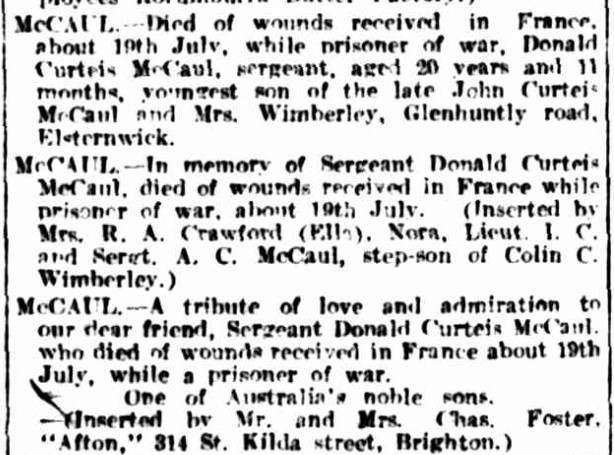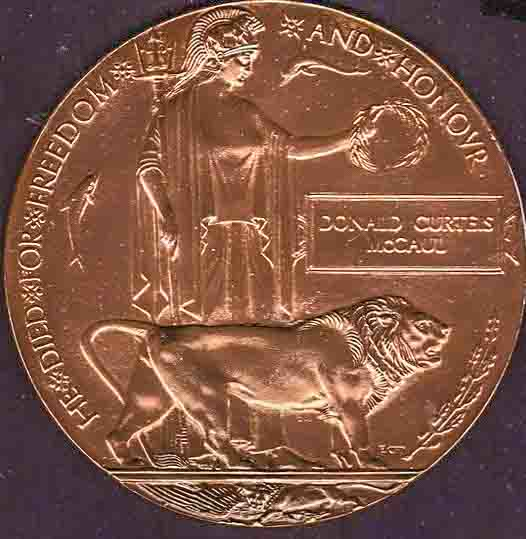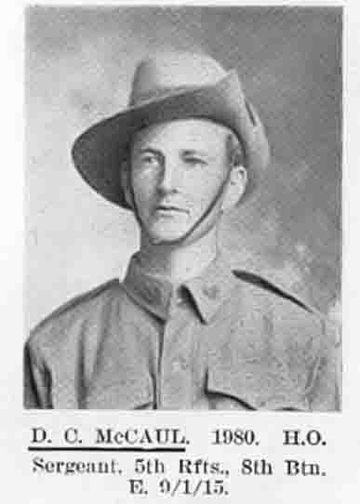
Donald Curteis MCCAUL
Eyes blue, Hair dark, Complexion fair
Three McCaul Boys, All Go to War
Can you help us identify Curteis?
Curteis was killed in Action at Fromelles. As part of the 60th Battalion he was positioned near where the Germans collected soldiers who were later buried at Pheasant Wood. There is a chance he might be identified, but we need help. We are still searching for suitable family DNA donors.
In 2008 a mass grave was found at Fromelles, a grave the Germans dug for 250 (Australian) bodies they recovered after the battle. Curteis’ body was recovered by the Germans, with his personal effects having been returned to his family in 1918.
If you know anything of contacts for Curteis here in Australia or his relatives from England, Scotland, Ireland, France and America please contact the Fromelles Association.
See the DNA box at the end of the story for what we do know about his family.
We particularly thank relative Denise McMahon for the McCaul family story and all the support to find potential DNA donors.
Early Life
Donald Curteis McCaul (known as Curteis) was born on 20 August 1895 in Elsternwick, Victoria. His father, John Curteis McCaul, had arrived from in England in September 1874 and settled in the northeast of Victoria. He married Emma Crawford in Beechworth, Victoria in April 1883. Emma and Curteis had 5 children:
- Ella Curteis McCaul 1884-1969
- Alice Nora McCaul 1886-1967
- John Curteis McCaul 1888-1969 (AIF – Captain)
- Alan Crawford McCaul 1888-1962 (AIF – Lieutenant)
- Donald Curteis McCaul 1895-1916 (AIF – Sergeant)
Both sides of Curteis’s family included Protestant ministers including, noted scholar Alexander McCaul, Doctor of Divinity, of Dublin.
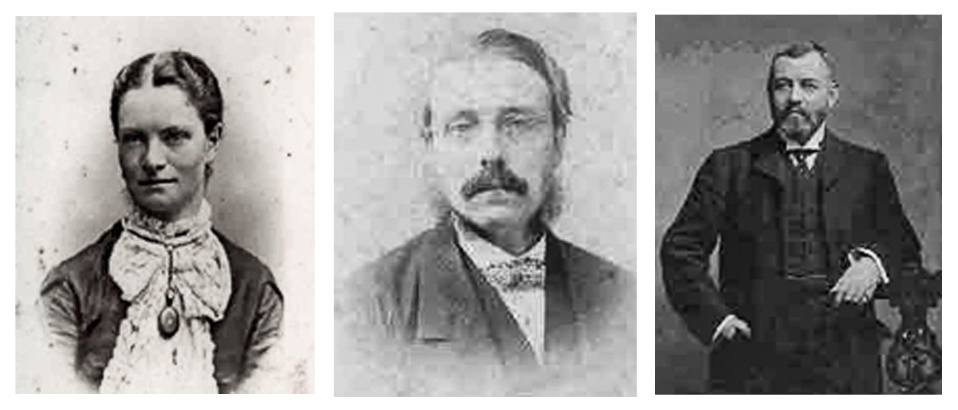
Unfortunately, Curteis’s father died from Asphyxia just 4 ½ months before Curteis was born. Emma did remarry, in 1906 to Colin Wimbeley. Curteis attended Brighton Grammar School and was a cadet in the Citizen Forces, 46th Infantry. After completing his education, he worked as a clerk for the Metropolitan Gas Company.
Sons off to War - Gallipoli
All three of the McCaul sons went off to War. Curteis and John (whom the family called Captain Jack) enlisted in early 1915 and Alan (known as Crawford) in late 1915. Jack also served as a Captain in WWII in the 9th Reserves Battalion from June 1941 to September 1943. Curteis was 19 years old when he enlisted and eligible to sign up on his own, but his mother Emma also gave her consent to her son’s enlistment. Curteis was assigned to the 5th Reinforcements of the 8th Battalion. Just three months after enlisting, the 19 year-old soldier was promoted to Sergeant and a month later he was aboard the HMAT Hororata A20, headed for Egypt and Gallipoli. Curteis’ 5th Reinforcements joined with the full 8th Battalion at Anzac Cove in mid-July.
As soon as they disembarked, the troops scurried to the comparative safety of the mouth of "Shrapnel Gully", then made its way up to Monash Valley and slowly climbed the steep slopes up to Steele's Post (adjacent to Courtney's Post), a vital link in the string of defensive posts along the Second Ridge. Curteis got his first taste of being in the trenches on 19 July, while they were under constant fire, as many as 300 shells a day, there were no major attacks by either side in Curteis’s first few weeks. Curteis’ 2nd Brigade fought in the major battle of Lone Pine in early August, but the 8th Battalion spent most of the time ‘standing by’ in support of the 6th battalion. The 8th then spent from mid-September to late-November on nearby Lemnos island.
The November weather at Gallipoli was awful, culminating in a blizzard that left over half a metre of snow on the ground. On 18 December Curteis departed Anzac Cove as part of the general evacuation of Gallipoli. They stayed at Lemnos until 2 January.
Egypt
After arriving in Egypt on 7 January, the 8th moved to the large camp at Tel-el-Kebir. On 2 February they moved to Serapeum, on the Suez Canal. With the impact of the Gallipoli campaign and the thousands of newly recruited soldiers arriving in Egypt from Australia, reorganization was inevitable. The 60th Battalion was formed in late February 1916 and Curteis was reassigned here, in D Company. It was made up of Gallipoli veterans from the 8th Battalion, a predominately Victorian unit, and new recruits from Victoria. After a month of training in the new battalion at Tel-el-Kebir, they had a two+ day, 50 km march with full equipment and 120 rounds of cartridges in thermometer-bursting heat across the Egyptian sands from Tel el Kebir to Ferry Post, near the Suez Canal.
Contrary to most of the other soldiers, Curteis wrote to his mother from Egypt that he had just finished the march and was feeling splendid. Emma shared this news with her sister in Oakham, Massachusetts in the US, as well as updates from her other sons and it was published in the local paper:
“Mrs. Martha A Malcolm, Maple Street, has received a letter from her sister (i.e. Curteis’ mother) in Australia telling of the departure of her last son for the front.
This young man, Crawford McCaul (i.e. Alan), has been appointed sergeant of his company and ... Melbourne with about 10,000 troops including infrantry, artillery, Red Cross, transports, etc.
The two other sons, John and Curteis, one a sergeant and the other a first lieutenant, were in the trenches at the Dardanells some months and in the evacuation. They were then sent to Egypt and later to Marseilles and Verdun. Mrs. Malcolm received a letter written to her sister by the defense department notifying her that Lieut. J McCaul was suffering from a gunshot wound in the right leg and was admitted to the hospital at Boulogne-on-the-Sea, where he remained a month and was then transferred to London where he was rapidly recovering.
Curteis McCaul aged 20 wrote from Egypt that he just finished a 37 mile march with full equipment and 120 rounds of cartridges and was feeling splendid. Mrs. Malcolm also received this letter from Lieut. John McCaul, which described his life at the front.
"I sent you a cable a few days ago to the effect that I had been wounded. It happend about 11.30 pm when a lance-corporal and I were patrolling the ground between our trenches and the German, and on our way home we both stopped bullets. It was a cold night and after being wounded we had to cross through an icy cold stream of water and then were taken through our entanglements into the trenches.”
The extent of my wounds are - Two channels through the calf of my right leg, in which the doctors have had tubes for four days, a couple of minor wounds where pieces of bullets have entered, and also a flesh wound in the back. The doctors removed bits of nickel and lead four days ago.
"Just now I had soup, chicken, vegetables, pudding and milk for dinner. However I am off to England in a few days and don't know how I shall fare there. I was billeted in a French woman's house a while, where the children were unruly and noisy. On my returning from duty one day I told the woman in my best French that I would like two hours' sleep. She immediately brought me 12 eggs having mistaken two hours for 12 eggs. While I am writing this, the guns are roaring 100 yards away, both sides going at their hardest. I pity the artillery men for it sounds a terrific duel, heavy howitzers are working and the noise and vibrations are awful."
Curteis and the 60th remained at Ferry Post until 1 June. Their time in Egypt was not all work, however. A 5th Division Sports Championship was held on 14 June, which was won by the 60th’s 15th Brigade. On 17 June they received orders to begin the move to the Western Front and boarded trains to move to Alexandria.
Fromelles
As about a quarter of the 60th Battalion officers and NCOs had experience at Gallipoli, thus were ‘well-seasoned’, it was anticipated they would make a great difference to the Western Front in France which had been a stalemate for well over a year. The majority of the battalion, 30 officers and 948 other ranks sailed on the Kinfauns Castle and, after a short stop in Malta, disembarked at Marseilles on 29 June 1916. Next came a three-day train trip, followed by a march from the rail station at Theinnes to the camp at Steenbecque, settling in on 2 July. On 7 July they began their move to Fleurbaix, arriving in Sailly on the 9th. Now just a few kilometres from the front, their training continued, surely with a higher intensity. The 60th were into the trenches on 14 July.
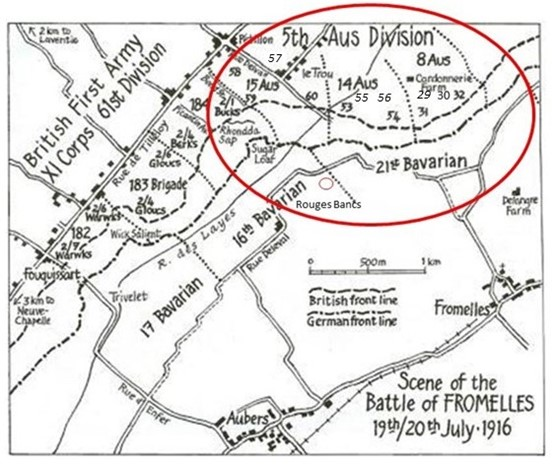
They were in position for an attack on 17 July, but it was postponed due to unfavourable weather. There was a gas alarm, but luckily it was just that. By 4.20 PM on 19 July, they were once again in position in the trenches, readying for their attack. Artillery shelling from both sides was constant. The 60th were given a very difficult position for the battle, with the ‘Sugar Loaf’ salient, a heavily fortified position with many machine guns, directly across from them. Fire from here could enfilade any troops advancing towards the front lines, giving the Germans a significant advantage. If the Sugar Loaf could not be taken, the Australian advances would also be subjected to counterattacks from that flank. A fellow soldier of the 15th Brigade, Private Bill Boyce (3022, 58th), summed the situation up well:
‘What have I let myself in for?’
The first of four waves of Aussies went over the parapet at 5.45 PM, with the last wave going over at 6.00 PM. As a platoon leader in D Company, Curteis would have been leading his fellow soldiers in the attack. Casualties were immediate and heavy. The 15th Brigade War Diaries captures the intensity of the early part of the attack – ‘they were enfiladed by machine guns in the Sugar Loaf and melted away.’
It was reported that some had been able to get to within 90 yards of the enemy trenches. One soldier said he:
‘believed some few of the battalion entered enemy trenches and that during the night a few stragglers, wounded and unwounded, returned to our trenches.’
Based on the Red Cross witness statement from Albert Boswell (2579), Curteis’ platoon had advanced about 50 yards from the parapet when he was shot – “He was hit and suddenly collapsed. I think he was killed outright.” With the ferocity of the battle, recovery of those who were killed was almost impossible.
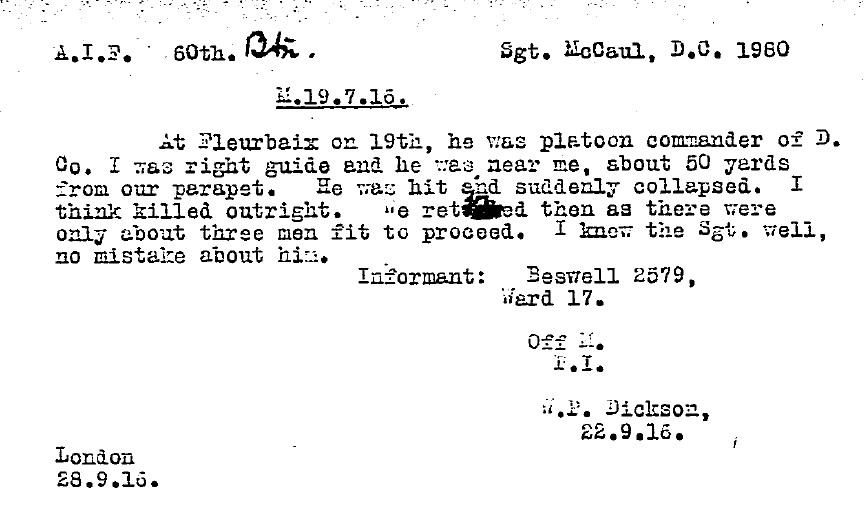
Albert Boswell received severe gunshot wounds to his shoulder, neck and hand, but survived the battle and the War and returned to Melbourne in 1919. Fighting continued through the night. With known high casualties in the 60th, they were relieved by the 57th Battalion at 7.00 AM. Roll call was held at 9.30 AM. In the ‘Official History of the War’, Charles Bean, Australia’s war historian, said ‘of the 60th Battalion, which had gone into the fight with 887 men, only one officer and 106 answered the call’.
Source Chapter XIII page 442
To get some perspective of the battle, when Charles Bean attended the battlefield two and half years later, he observed a large amount of bones, torn uniforms and Australian kit still on the battlefield. The final impact of the battle on the 60th was that 395 soldiers were killed or died of wounds, of which 315 were not able to be identified.
Curteis’ Fate
Curteis was initially reported as missing in action. A communication was received from the Germans dated 15 August stating that they had found him ‘in Gegend Fromelles gefallen’ (fallen in the area) and he was included on the German’s ‘Death List’.
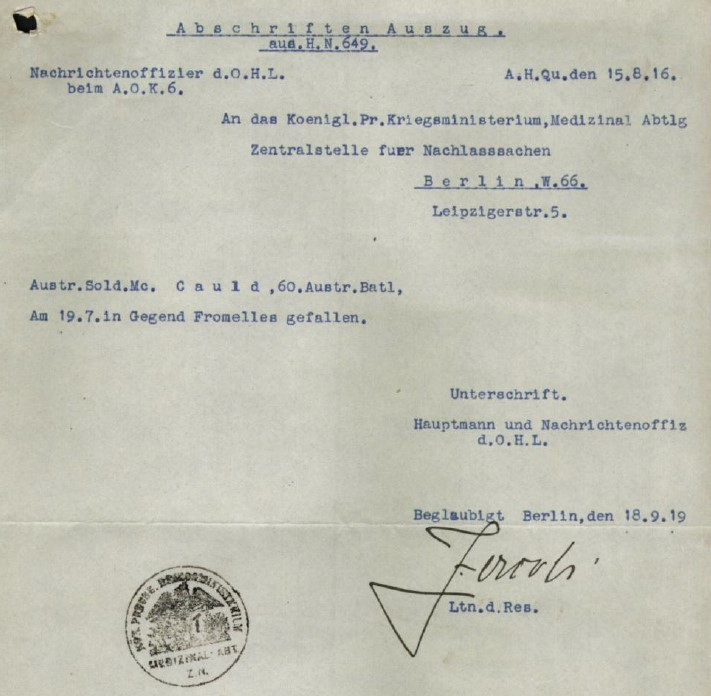
With all the casualties from the battle, getting information channels back to the family were slow. His Aunt in England had written several letters to the Red Cross during September 1916 asking for details. The Red Cross seem to have made every effort and finally reported to her on 11 October, confirming Curteis' death, with their condolences.

They also advised his brother Jack on 24 November, who was at 1 Camp in Salisbury. Jack had been wounded in the calf in April at Pozieres and this left him unfit for further combat service. He served the rest of the War in the UK. Curteis was formally declared as being killed in action on 16 September 1916. His personal goods, which contained a purse, a rosary and his N.C.O. certificate were returned to his mother in 1918. As with many of the soldiers that the Germans recovered, several Red Cross records state he was a Prisoner of War, but that he died on the 19th. There is also a record dated 28 April 1919 which states “buried” and has a map reference, but the location is far from the battle site. Curteis was clearly missed by his family and friends.
After the War
Curteis is memorialized on Panel 18 at the VC Corner Cemetery Memorial, Fromelles.

He received the 1914/15 Star Medal, the British War Medal and the Victory Medal, as well as a Memorial Plaque and a Memorial Scroll.
While he has no grave of his own, he is memorialized on the grave of his parents in the St. Kilda Cemetery, Melbourne.

Curteis’ brothers Jack and Alan returned to Australia at the end of the War and they went back to their rubber plantations in Malaya.
Could Curteis Still be Found?
After the battle, the Germans did recover the bodies of 250 soldiers and placed them in a mass grave at Pheasant Wood. This grave was only discovered in 2008. A major effort has been in progress since then to identify the soldiers in the grave via DNA testing of family members. As of 2024, 180 of these soldiers have been able to be identified. Searches for family members to contribute DNA to identify the remaining soldiers is continuing. We do know that the Germans found Curteis’ body. However, to date (2024), just two of the 315 unidentified soldiers from the 60th Battalion have been found to be in the grave, but there still is hope. Curteis’ relative Denise McMahon has been pursuing potential contributors.
“While in constant contact with me over the years following the discovery of the mass grave at Fromelles the Army asked for a list of descendants down the male line.
Curteis’ brother Alan’s had a son John Curteis Crawford McCaul who died in Bundaberg in 1988 and Curteis was single, so I could only offer a direct female line from Curteis’ sister Ella. This DNA was sent to my cousin in the USA, but no firm answer has yet been received from either the Army or the subsequent research teams, as to the success or otherwise of this DNA. An English ancestor’s descendant through the male line also provided DNA but this was not successful. However, the Army contacted me some years ago and said we know he was in that mass grave. All we need now for a headstone for the grave marked unknown at Fromelles, is a successful DNA.”
Potential relatives in England, France and the US have been identified. Family names of particular interest are, Fadum, Perez, Scheffer and Niven. If you know anything of contacts for Curteis here in Australia or his relatives from England, Scotland, Ireland, France or America, please contact the Fromelles Association.
Contact is sought with family of Donald, especially with McCaul family originally living in Scotland.
| Soldier | Donald Curteis McCaul (1895 – 1916) |
| Parents | John Curteis McCaul (1864-1895) b Aberdeenshire and Emma McNeil Crawford (1858-1927) b Beechworth, Victoria, d Elsternwick, Victoria |
| Siblings | Ella Curteis McCaul (1884-1969) b Whorouly, Vic died Frankston, Vic, married Robert Alexander Crawford, sons Colin, Robert Curteis, John Sharman | ||
| Alice Nora McCaul (1886-1967) b Whorouly, Vic Died Malvern, Vic married Frederick James Niven One son, James Curteis Niven | |||
| John Curteis McCaul (1888-1969) b St Giles London, died Melbourne, m Gwendoline Dundas, 3 daughters | |||
| Alan Crawford McCaul (1888-1962) b St Giles London, d East St Kilda, Vic, m Phyllis Foye, one son John Curteis Crawford, d Bundaberg 1988 |
| Grandparents | |||
| Paternal | John Clarke Crossthwaite McCaul (1832-1903) and Elizabeth Fanny Curteis | ||
| Maternal | Hiram Allen Crawford and Anna McNeil (1834-1862) Portree, Inverness-shire |
Note. Paternal gg Grandfather- Alexander McCaul DD (1799-1863), Dublin, Ireland. Other family line names – Kravitt, Daniels, Fadum
The Fromelles Association would love to hear from you

Contacts
(Contact: carla@fromelles.info or geoffrey@fromelles.info).
(Contact: army.uwc@defence.gov.au or phone 1800 019 090).
Donations
If you are able, please contribute to the upkeep of this resource.
(Contact: bill@fromelles.info ).


